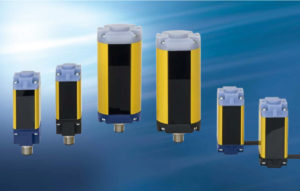 The new SLB 240/440/450 range of safety light barriers have built-in analysis and impressively small dimensions. This means the SLB 240/440 with cable connection and dimensions of WHL 28x32x72 mm or with connector socket (WHL 28x32x91 mm) can be used in very confined spaces and can be mounted quickly and easily. Both models have a range of 15 metres, while the SLB 450 (dimensions DL 49 x 126 mm) can achieve a range of up to 75 metres. One major advantage of the SLB 240/440/540 range is that it can be used for a wide range of applications in processing centres for assembly/handing and in the wood, paper and printing industry,
The new SLB 240/440/450 range of safety light barriers have built-in analysis and impressively small dimensions. This means the SLB 240/440 with cable connection and dimensions of WHL 28x32x72 mm or with connector socket (WHL 28x32x91 mm) can be used in very confined spaces and can be mounted quickly and easily. Both models have a range of 15 metres, while the SLB 450 (dimensions DL 49 x 126 mm) can achieve a range of up to 75 metres. One major advantage of the SLB 240/440/540 range is that it can be used for a wide range of applications in processing centres for assembly/handing and in the wood, paper and printing industry,  high-shelf warehouses or packaging machines. The single beam safety light barriers are particularly useful for securing smaller hazard areas, such as machines with small openings or slots, in assembly machines for circuit boards, for example.
high-shelf warehouses or packaging machines. The single beam safety light barriers are particularly useful for securing smaller hazard areas, such as machines with small openings or slots, in assembly machines for circuit boards, for example.
Also suitable for process protection
All SLB light barriers have safe semiconductor outputs (2 x PNP) and can be included directly into the safety circuit, even without external safety evaluation. In accordance with IEC 61496, the new product range complies with the requirements for all Type 2 or Type 4 applications. They are then used for process protection, for example in high-shelf warehouses, where deviations from predefined positions are detected by means of object recognition and height recording, thus preventing collisions and damage.
The SLB 450 version, which can monitor access areas of up to 75 metres, is also fitted with an optional built-in heater so it can be used in very low temperatures (down to -30°C). This means it can be used outside, for example in the wood or cement industry, in gravel pits or docks.
Visual set-up guide simplifies commissioning
All versions have a visual set-up guide which makes commissioning significantly easier. At the same time, they have a 4-way coding level, so that if multiple light barriers are used in one application, up to four sensor pairs can be operated in one direction without influencing one another. Configuration does not require tools such as PC’s or commissioning systems, it simply uses a command device such as a button. Set-up, automatic and restart modes and a diagnostics mode are available.

